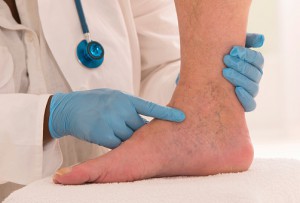Most people with spider veins often don’t notice them until they discover that they have a whole crop of them. These squiggly looking veins can appear all over the body, but most commonly they are seen in the ankles, feet, legs, thighs, and face.
What Are Spider Veins?
The medical term for spider veins is telangiectasias. They are baby varicose veins. They are up to 1 mm in diameter and typically are reddish in color. They are most commonly found on the lower extremities and face. They are often seen coming off slightly larger bluish looking veins. These bluish veins can be part of normal anatomy. They, by definition, are 1-3 mm in diameter. They can also become tortuous, irregular, and dilated [varicose].
People think that they suddenly develop spider veins. However, these veins were most likely present since birth. They were just normal in size and were not visible. Over time, they slowly dilate up to the point where they become noticeable.
I like to divide spider vein patients into 2 categories. The first and the most common group consists of those who have spider veins in their lower extremities and who, upon further investigation, have significant underlying vein disease. That is, a standing upright ultrasound evaluation will reveal that a large percentage of these patients have significant underlying vein disease characterized by vein valve dysfunction and the accompanying venous high pressure [hypertension] in their superficial and sometimes their deep venous system.
The second group of spider vein patients do not have underlying superficial or deep venous disease. What they do have is local factors that have resulted in the development of these tiny varicosities. Some of the local factors include: a genetic predisposition toward the development of spiders that they inherited, an area of injury or repeated mild trauma, a growth in the skin, an area of previous surgery [trauma], where there is a large area of fat accumulation, on the skin of the face or legs where there has been lots of sun exposure, and areas on the skin and legs where there has been chronic inflammation [e.g. rosacea].
Are Spider Veins Dangerous?
Spider veins themselves are not dangerous—remember they are up to only 1 mm in diameter. However, if a patient has spider veins and are in the first group described above, spider veins could be a warning that there is possibly something more serious going on in the venous system. A person who is Board Certified in Venous Disease can advise you on whether your spider veins are the result of a more serious underlying problem.
Do I Need to Have My Spider Veins Removed?
Spider vein removal is considered cosmetic and not a medically necessary procedure by all insurance companies. Occasionally patients report painful spider veins. However, in almost all cases they are asymptomatic and unsightly. That makes removal a personal choice for each patient.
How are Spider Veins Removed?
The first thing to mention is that the best cosmetic results are obtained by treating the underlying venous hypertension, if present. The second thing to mention is that the cosmetic results are better if a patient wears medical grade support hose for 2-3 weeks after the procedures.
The simplest, easiest, and most cost effective way to treat spiders on the lower extremities is to start with sclerotherapy [injections]. The modern medicines do a very good job of eliminating the spiders if the injections are done by a qualified person. For the tiny spiders that are too small for the smallest needle, the Vein Wave works well.
Spider veins and larger veins on the face can be easily treated using the Vein Wave. Click here to read more about the Vein Wave.
There are different lasers that can be used. I feel that in the hands of an expert this technology can be used. However, it is costly, potentially dangerous, and does not give as good of results that the other methods do.


